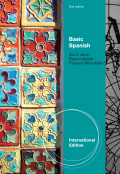
Basic spanish: the basic spanish series, international edition
Jarvis, Ana
Lebredo, Raquel
Mena-Ayllón, Francisco
THE BASIC SPANISH SERIES, International Edition offers a flexible, concise introduction to Spanish grammar and communication with state-of-the-art online learning tools to better address the needs of today's students and professionals who need a working knowledge of Spanish. For the second edition, we maintainthe strengths of the program while making it more accessible to all students of Spanish. We are proud to offer an extensive technology program with this edition, thereby improving students' access to required materials and giving instructors the freedom to design their courses in the way that best meets their students' needs. INDICE: Preface. Lección preliminar I. Communication: You will learn to greet people and exchange some polite questions and answers, exchange phone numbers, talk about days and dates, and describe colors. Structures:1. Greetings and farewells. 2. Cardinal numbers 0-39. 3. The alphabet 4. Days of the week. 5. Months of the year. 6. Colors. Lección preliminar II. Communication: You will learn about cognates and some simple vocabulary related to the classroom. Structures: 1. Gender and number. 2. The definite and indefinite articles 3. Subject pronouns. 4. The present indicative of ser. 5. Uses of hay. 6. Cardinal numbers 40-299. Lección 1. Communication: you will learn vocabulary related to restaurants and cafeterias. Country highlighted: España. Structures:1. The present indicative of regular -ar verbs 2. Interrogative and negative sentences. 3. Forms and position of adjectives 4. Telling time. 5. Cardinal numbers 300-1,000. Lección 2. Communication: You will learn additional vocabulary relate torestaurants. Country highlighted: México. Structures: 1. Agreement of adjectives, nouns, and adjectives. 2. The present indicative of regular -er and -ir verbs. 3. Possession with de 4. Possessive adjectives. 5. The personal a. Lección 3. Communication: you will learn vocabulary related to the family. Country highlighted: Guatemala. Structures: 1. The irregular verbs ir, dar, and estar.2. Ir a+ infinitive 3. Uses of the verbs ser and estar. 4. Contractions. Lección 4. Communication: You will learn vocabulary pertaining to hotels. Countries highlighted: Honduras and El Salvador. Structures: 1. The irregular verbs tener and venir. 2. Expressions with tener. 3. Comparative forms. 4. Irregular comparative forms. Lección 5. Communication: You will learn vocabulary about typical activities related to traveling in a foreign country. Country highlighted: Nicaragua. Structures: 1. Stem-changing verbs (e:ie). 2. Some uses of the definite article. 3. The present progressive. 4. Ordinal numbers: Cuanto sabe usted ahora? Lecciones 1-5. Lección 6. Communication: You will learn more vocabulary related to situations encountered while traveling. Countries highlighted: Costa Rica and Panama. Structures: 1. Stem-changing verbs (o:ue). 2. Affirmative and negative expressions. 3. Pronouns as object of a preposition. 4. Direct object pronouns. Lección 7. Communication: You will learn vocabulary related to travel arrangements. Countries highlighted: Puerto Rico. Structures: 1. Stem-changing verbs (e:i). 2. Irregular first-person forms. 3. Saber contrastedwith conocer. 4. Indirect object pronouns. Lección 8. Communication: You willlearn vocabulary to sports and other outdoor activities. Countries highlighted: Cuba and Republica Dominicana. Structures: 1. Pedir contrasted with preguntar. 2. Special construction with gustar, doler, and hacer falta. 3. Demonstrative adjectives and pronouns. 4. Direct and indirect object pronouns used together. Lección 9. Communication: You will learn vocabulary related to daily routine and personal grooming. Country highlighted: Venezuela. Structures: 1. Possessive pronouns. 2. Reflexive constructions. 3. Command forms: Ud. and Uds. 4.Uses of object pronouns with command forms. Lección 10. Communication: you will learn vocabulary related to housework, shopping and weather. Country highlighted: Colombia. Structures: 1. The preterit of regular verbs. 2. The preteritof ser, ir and dar. 3. Uses of por and para. 4. Seasons of the year and weather expressions ¿Cuánto sabe usted ahora? Lecciones 6-10. Lección 11. Communication: You will learn vocabulary related to everyday life. Country highlighted:Ecuador. Structures: 1. Time expressions with hacer. 2. Irregular preterits. 3. The preterit of stem-changing verbs (e:i and o:u). 4. Command forms: tú. Lección 12. Un matrimonio peruano va de compras. Structures: 1. En and a as equivalents of at. 2. The imperfect tense. 3. The past progressive. 4. The preterit contrasted with the imperfect. Communication: Shopping for clothes. Culture:Perú. Different ways of shopping in the Hispanic world. Lección 13. En una tienda por departamentos en La Paz. Structures: 1. Changes in meaning with the imperfect and preterit of conocer, saber, and querer. 2. Hace meaning ago. 3. Uses of se 4. ¿Qué? and ¿Cuál? used with ser. Lección 14. Communication: You will learn vocabulary related to automóviles. Country highlighted: Paraguay. Structures: 1. The past participle. 2. The present perfect tense. 3. The past perfect (pluperfect) tense. Lección 15. Communication: You will learn vocabulary related to transportation. Country highlighted: Chile. Structures: 1. The future tense. 2. The conditional tense. 3. Some uses of the prepositions a, de, and en. ¿Cuánto sabe usted ahora? Lecciones 11-15. Lección 16. Communicaton: Youwill learn vocabulary related to traveling by train. Country highlighted: Argentina. Structures: 1. The present subjunctive. 2. The subjunctive with verbs of volition. 3. The absolute superlative. Lección 17. Communication: You will learn vocabulary related to hospital care in emergencias. Country highlighted:Uruguay. Structures:1. The subjunctive to express emotion. 2. The subjunctivewith some impersonal expressions. 3. Formation of adverbs. Lección 18. Communication: You will learn vocabulary related to collage life. Nationality highlighted: Los puertorriqueños. Structures: 1. The subjunctive to express doubt, disbelief, and denial. 2. The subjunctive to express indefiniteness and nonexistence. 3. Diminutive suffixes. Lección 19. Communication: You will learn vocabulary related to health problems and visits to the doctor's office. Nationality highlighted: Los mexicanoamericanos. Structures: 1. The subjunctive after certain conjunctions. 2. The present perfect subjunctive
- ISBN: 978-0-495-90277-5
- Editorial: Heinle & Heinle
- Encuadernacion: Rústica
- Páginas: 400
- Fecha Publicación: 31/01/2010
- Nº Volúmenes: 1
- Idioma: Inglés
